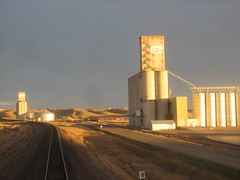 Despite a drought-induced corn shortage in the United States this past summer, the United Nations Food and Agriculture Organization estimated a 1 percent increase in worldwide grain production for 2012 – even after a record-breaking yield of 2,295 million tons in 2011. That’s a lot of grain that must be cleaned, processed and stored in silos to await export.
Despite a drought-induced corn shortage in the United States this past summer, the United Nations Food and Agriculture Organization estimated a 1 percent increase in worldwide grain production for 2012 – even after a record-breaking yield of 2,295 million tons in 2011. That’s a lot of grain that must be cleaned, processed and stored in silos to await export.
Heavy-duty grain elevators are required to move such large volumes of food from place to place. While most people probably don’t give a thought to how wheat, corn and other grains are handled, we at Mar-Dustrial are aware of how integral grain elevators are to agricultural production – largely because we supply the Falk gear reducer components that slow down their rotational speed. Grain elevators are typically used for:
- Loading grain into silos for storage.
- Transporting grain between various levels of a mill for processing.
- Transferring grain to and from barges or trains for export.
History of Grain Elevators
Before industrial conveyor systems were invented to help transport large volumes of loose grain, crop yields were partitioned into sacks, which then had to be hauled up and down by hand, via pulleys or on the backs of dockworkers.
The earliest version of the grain elevator was invented by Oliver Evans, who during the 1780s revolutionized manufacturing with his automatic flour mill in Newcastle County, Del. The mill, which automatically performed all tasks so the miller had only to start and stop the machinery, included a system of bucket elevators and conveyors to move the grain between the various floors of the mill. When the U.S. Patent Office first opened in 1790, Evans’ automated flour milling machinery was the third invention to receive a federal patent.
Later inventors adapted Evans’ invention to automate grain transport at other points in the export process. In the 1840s, a merchant named Joseph Dart spearheaded the first official steam-powered grain elevator to help load and unload grain from ships in Buffalo, N.Y. Previously, it could take up to a week to unload a single grain-laden ship; Dart’s elevator worked seven times faster than non-mechanized methods.
These days, grain elevators are a common sight in mills and distribution centers. In fact, the distribution of grain revolves around the location and availability of large terminal elevators, which serve as the launching point for the nation’s grain supply.
[ Photo by: designatednaphour, via CC License ]
Posted under Products/Services on Tuesday, January 15th, 2013
